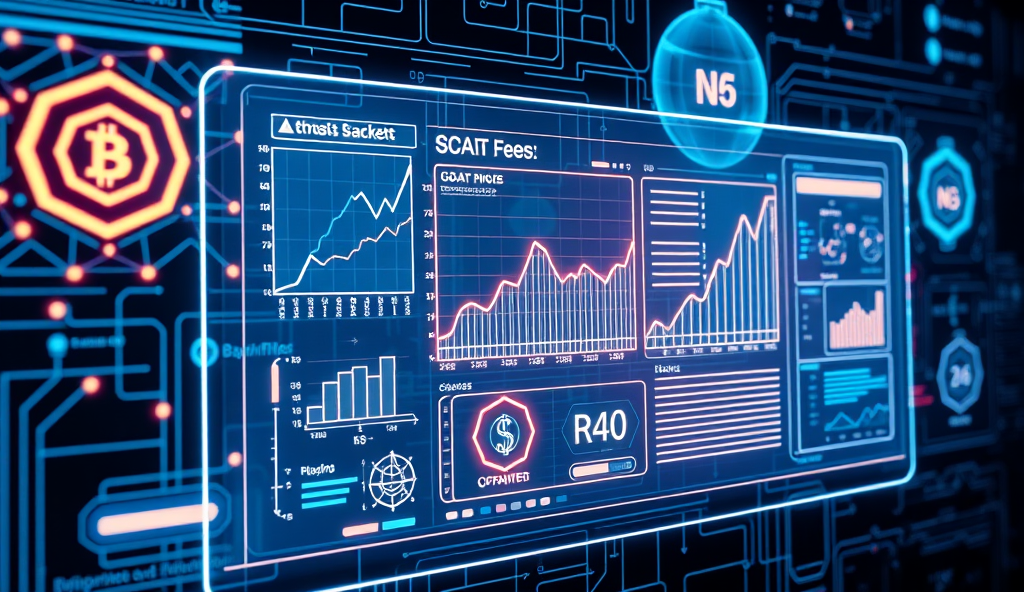Introduction to Algorithmic Stablecoins and Their Importance in Cryptocurrency Markets
Algorithmic stablecoins represent a unique class of cryptocurrencies designed to maintain price stability through automated mechanisms rather than traditional collateral. Unlike fiat-backed stablecoins, these digital assets rely on smart contracts and algorithmic adjustments to balance supply and demand, offering a decentralized alternative for investors in volatile markets.
Their importance in cryptocurrency markets stems from their potential to provide stability without centralized reserves, addressing key limitations of collateralized stablecoins. Projects like TerraUSD (before its collapse) and Ampleforth demonstrated how algorithmic stablecoins can integrate with DeFi ecosystems, though their risks became evident during market stress tests.
As we explore how algorithmic stablecoins work in the next section, it’s crucial to understand their role in shaping decentralized finance. These instruments offer innovative solutions but also present unique challenges that investors must carefully evaluate before participation.
Key Statistics

Understanding the Mechanism Behind Algorithmic Stablecoins
Algorithmic stablecoins represent a unique class of cryptocurrencies designed to maintain price stability through automated mechanisms rather than traditional collateral.
Algorithmic stablecoins maintain price stability through smart contracts that automatically adjust token supply based on market demand, expanding circulation when prices rise and contracting it when prices fall. For example, Ampleforth’s protocol rebases daily, altering wallet balances to keep its token close to $1, demonstrating how algorithmic stablecoins work without direct collateral backing.
These systems often incorporate dual-token models, where one token maintains stability while another absorbs volatility, as seen in Terra’s LUNA-UST pairing before its collapse. By algorithmically incentivizing arbitrage opportunities, these designs theoretically stabilize prices, though real-world stress tests like Terra’s $40 billion crash revealed vulnerabilities in extreme market conditions.
The next section will break down the key components that enable algorithmic stablecoins to target price stability, from seigniorage mechanisms to governance tokens. Understanding these elements is critical for investors evaluating risks versus rewards in decentralized finance ecosystems.
Key Components of Algorithmic Stablecoins That Ensure Price Stability
Frax Finance exemplifies hybrid algorithmic stablecoin design, combining seigniorage mechanics with 92% collateralization as of Q2 2023, demonstrating resilience during market shocks that collapsed purely algorithmic models.
Seigniorage mechanisms form the backbone of algorithmic stablecoins, using smart contracts to mint or burn tokens based on demand fluctuations, as seen in Ampleforth’s daily rebasing. These protocols often integrate oracles like Chainlink to feed real-time price data, ensuring accurate supply adjustments when deviations from the peg exceed thresholds like 1-2%.
Governance tokens play a dual role, allowing holders to vote on protocol upgrades while absorbing volatility—similar to Terra’s LUNA, which was designed to stabilize UST before its collapse. Some projects, like Frax Finance, combine algorithmic and collateralized elements, maintaining partial reserves to mitigate risks exposed during events like Terra’s $40 billion depegging.
Arbitrage incentives are algorithmically encoded, rewarding traders who correct price imbalances, though over-reliance on this mechanism contributed to Terra’s death spiral. The next section will analyze these components in action through a case study of a leading algorithmic stablecoin, revealing practical strengths and systemic vulnerabilities.
Case Study: A Deep Dive into a Popular Algorithmic Stablecoin
The collapse of TerraUSD (UST) in May 2022 remains the most dramatic case study of algorithmic stablecoin failure, losing its peg after a bank run depleted its sister token LUNA’s reserves, erasing $40B in market value.
Frax Finance exemplifies hybrid algorithmic stablecoin design, combining seigniorage mechanics with 92% collateralization as of Q2 2023, demonstrating resilience during market shocks that collapsed purely algorithmic models. Its fractional reserve system dynamically adjusts between algorithmic expansion and collateral backing, avoiding Terra’s death spiral scenario while maintaining lower volatility than Ampleforth’s purely rebasing approach.
The protocol’s governance token FXS serves dual purposes—absorbing price volatility through burn/mint mechanisms while allowing decentralized voting on critical parameters like collateral ratios. This contrasts with Terra’s LUNA, which lacked sufficient safeguards when UST demand collapsed, highlighting Frax’s risk-mitigation advantages through its partial collateral buffer.
Real-world performance data shows Frax maintained its peg within 0.3% deviation during the 2022 crypto winter, outperforming competitors by leveraging Chainlink oracles for precise supply adjustments. The next section will examine how such algorithmic stablecoins withstand extreme market volatility through these engineered stabilization mechanisms.
How Algorithmic Stablecoins Respond to Market Volatility
Emerging projects like Reserve Protocol are testing multi-asset backing combined with algorithmic adjustments, aiming to reduce volatility while maintaining decentralization, with its RSV token achieving 98% peg stability during 2023's market turbulence.
Algorithmic stablecoins like Frax deploy real-time supply adjustments through smart contracts, expanding circulating tokens during price surges and contracting supply when demand falls, as seen in its 0.3% peg stability during 2022’s market crash. These mechanisms rely on decentralized oracles like Chainlink to feed accurate price data, enabling precise algorithmic reactions that purely collateralized stablecoins cannot match.
Hybrid models combine algorithmic elasticity with partial collateral buffers, allowing protocols to absorb shocks without triggering death spirals—Frax’s 92% collateralization in Q2 2023 provided stability while maintaining capital efficiency. This contrasts with Terra’s purely algorithmic approach, where missing safeguards led to UST’s collapse when demand evaporated abruptly.
During extreme volatility, governance tokens like FXS activate burn/mint functions to stabilize prices, while community voting adjusts parameters like collateral ratios dynamically. Such engineered responses explain why algorithmic stablecoins outperform purely rebasing or collateralized alternatives in turbulent markets, though inherent risks remain—as explored next.
Challenges and Risks Associated with Algorithmic Stablecoins
Algorithmic stablecoins represent an innovative yet risky approach to price stability in crypto, as demonstrated by both their successes and failures like TerraUSD.
Despite their engineered stability mechanisms, algorithmic stablecoins face systemic risks like oracle failures—if price feeds lag or malfunction, as happened during Chainlink’s 2021 downtime, smart contracts may execute incorrect supply adjustments. The TerraUSD collapse demonstrated how sudden loss of confidence can trigger death spirals, with UST’s market cap plummeting 98% in days despite its algorithmic design.
Regulatory uncertainty compounds these risks, as seen when the EU’s MiCA framework initially excluded algorithmic models from its stablecoin definitions, creating compliance hurdles. Even hybrid systems like Frax remain vulnerable to liquidity crunches if collateral assets (like USDC) face depegging events, as occurred during Silicon Valley Bank’s collapse in March 2023.
These challenges highlight why algorithmic stablecoins require robust stress-testing and contingency plans—a transition point for comparing their risk profiles against collateralized alternatives next.
Comparing Algorithmic Stablecoins with Other Types of Stablecoins
Unlike collateralized stablecoins such as USDC or DAI, which rely on asset-backed reserves, algorithmic stablecoins use smart contracts to dynamically adjust supply, offering capital efficiency but higher volatility risks as seen in TerraUSD’s collapse. Fiat-backed models provide stronger price stability through 1:1 reserves, yet face centralized custody risks like the USDC depegging during the 2023 banking crisis.
Hybrid designs like Frax combine algorithmic mechanisms with partial collateralization, balancing efficiency with reduced systemic risk, though they remain vulnerable to liquidity shocks in their reserve assets. Crypto-collateralized stablecoins like DAI mitigate oracle risks through overcollateralization but require larger capital lockups, limiting scalability compared to purely algorithmic models.
These trade-offs highlight why algorithmic stablecoins appeal to DeFi purists seeking decentralization, despite their higher failure rates under stress—a reality we’ll examine through real-world case studies next.
Real-World Examples of Algorithmic Stablecoins in Action
The collapse of TerraUSD (UST) in May 2022 remains the most dramatic case study of algorithmic stablecoin failure, losing its peg after a bank run depleted its sister token LUNA’s reserves, erasing $40B in market value. This event validated concerns about purely algorithmic models’ vulnerability to speculative attacks, contrasting with hybrid systems like Frax Finance, which survived the same period with its 92% collateralized v2 model.
Ampleforth’s elastic supply mechanism demonstrates an alternative approach, using daily rebasing to adjust token holdings proportionally across wallets, though its AMPL token still experienced 300% volatility in 2021. Meanwhile, newer entrants like USDM employ overcollateralized crypto reserves with algorithmic minting, blending DAI’s safety features with dynamic supply adjustments favored by DeFi protocols.
These examples underscore why algorithmic stablecoins remain high-risk experiments despite their theoretical advantages, setting the stage for examining whether next-generation innovations can solve their fundamental stability challenges. The evolving landscape suggests hybrid models may dominate future development, as we’ll explore in analyzing upcoming algorithmic stablecoin advancements.
Future Prospects and Innovations in Algorithmic Stablecoins
Emerging projects like Reserve Protocol are testing multi-asset backing combined with algorithmic adjustments, aiming to reduce volatility while maintaining decentralization, with its RSV token achieving 98% peg stability during 2023’s market turbulence. Meanwhile, research into AI-driven monetary policies, such as those proposed by the Gyroscope Protocol, could enable real-time supply adjustments based on predictive market analytics rather than reactive mechanisms.
Regulatory-compliant models are gaining traction, exemplified by Mountain Protocol’s USDM, which combines SEC-approved treasury bills with algorithmic minting to offer yield-bearing stability—a hybrid approach attracting $150M TVL within six months of launch. These innovations suggest algorithmic stablecoins may evolve beyond speculative tools into viable DeFi infrastructure if they balance innovation with risk mitigation.
The next phase of development will likely focus on interoperability, as seen with LayerZero-powered cross-chain stablecoins like Stargate’s hybrid model, addressing fragmentation while preserving stability mechanisms. This progression sets the stage for examining algorithmic stablecoins’ long-term role in cryptocurrency ecosystems.
Conclusion: The Role of Algorithmic Stablecoins in the Future of Cryptocurrency
Algorithmic stablecoins represent an innovative yet risky approach to price stability in crypto, as demonstrated by both their successes and failures like TerraUSD. Their ability to operate without full collateralization makes them uniquely suited for DeFi applications, though regulatory scrutiny remains a key challenge moving forward.
The future of algorithmic stablecoins hinges on improved mechanisms for maintaining peg stability during extreme market volatility, as seen in recent case studies. Projects like Frax and Ampleforth show promise with hybrid models combining algorithmic and collateralized elements, offering lessons for future iterations.
As the crypto ecosystem evolves, algorithmic stablecoins will likely play a growing role in decentralized finance if they can address scalability and trust issues. Their success ultimately depends on balancing innovation with risk management, a lesson underscored by past market events.
Frequently Asked Questions
How can I evaluate the stability risks of an algorithmic stablecoin before investing?
Check the project's historical peg deviations and stress test results using tools like DeFiLlama to analyze performance during past market crashes.
What tools help monitor algorithmic stablecoin supply adjustments in real-time?
Use blockchain explorers like Etherscan combined with protocol dashboards such as Frax Finance's analytics page to track mint/burn events and collateral ratios.
Can algorithmic stablecoins maintain their peg without collateral during a crypto bear market?
Pure algorithmic models often fail in bear markets so prioritize hybrid stablecoins like Frax that combine algorithms with partial collateral buffers for better protection.
How do I assess the governance token's role in an algorithmic stablecoin system?
Review the tokenomics documentation to understand volatility absorption mechanisms and use voting tracker tools like Tally to evaluate governance participation rates.
What are the key red flags to watch for in algorithmic stablecoin projects?
Avoid projects with excessive reliance on single oracle systems or lacking circuit breakers—use RugDoc.io to audit smart contract risks before investing.





